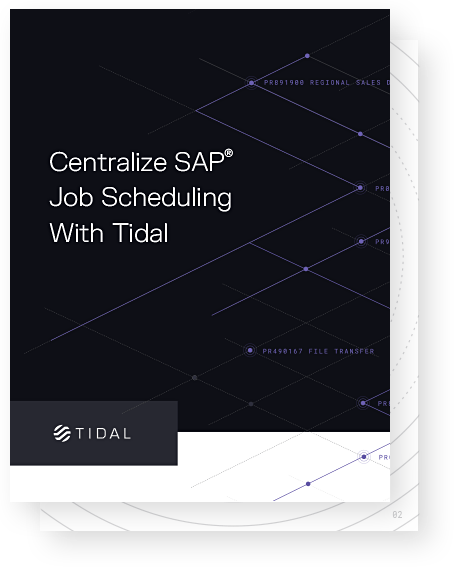Optimize ERP Scheduling
Tidal offers pre-built integrations for the different versions and technology stacks from SAP:
- R/3 ERP & BW (ABAP)
- S/4HANA ERP & BW (ABAP)
- S/4HANA ERP (Java)
Our adapters work through the SAP API to take control of the activities in the embedded scheduler. Tidal seamlessly manages those scheduling tasks with more advanced scheduling functionality than SAP’s native scheduler offers.
Automate time-based scheduling across global time zones
Leverage dozens of business and regional calendars out-of-the-box
Use event-based automation in your schedules
Define SLA policies and manage performance against SLAs
Build dependencies with other application workflows or tasks
Execute file transfers between SAP and other applications
SAP-specific Jobs
SAP-specific scheduling constructs are pre-populated in the Tidal UI for easy setup and management.
Manage SAP dunning jobs to trigger invoices
Manage BW info packages and process chains
Support for SAP IS-U
Our integrations for SAP ERP also support SAP IS-U (SAP Utilities), a process-oriented application from SAP built for the utilities industry. With our adapter for SAP ERP, energy suppliers and other utility companies can leverage Tidal to centrally manage the service and business processes in SAP IS-U and apply more advanced scheduling functionality.

OUR CORE PLATFORM
Tidal Automation
A unified platform for centralized management and control of job scheduling across business, operations and IT processes. Tidal Automation Platform >
Frequently Asked Questions
-
What types of jobs can I schedule with the SAP ERP Job Scheduler integration for Tidal?
Using Tidal, teams can schedule and automate a wide range of jobs, including batch jobs, job processing, data loads, database maintenance, spools, and other routine tasks. With Tidal’s intuitive user interface, scheduling across ERP systems and other applications is as easy as dragging and dropping. You can even use Tidal’s range of pre-built job scheduling templates to get up and running lightning quick.
Discover more about Tidal’s integrations with the SAP solution set.
-
Are job steps and job definitions in Tidal and SAP ERP job scheduling the same?
Job steps and job definitions in Tidal and SAP are similar but have a few key differences. Tidal provides a more abstract, high-level view of job workflows. This enables users to define job definitions that can include multiple job steps and dependencies. In SAP ERP, there is more granular control with exection, however that is limited only to automated processes that reside within SAP, whereas Tidal can automate processes across your entire environment.
Explore the modern capabilities of Tidal’s enterprise workload automation platform.
-
How does Tidal compare to other job schedulers like Redwood and Stonebranch?
Tidal differs from Redwood and Stonebranch in a few key areas. First, Tidal’s user interface is modern and intuitive with drag-and-drop job scheduling and management, while Stonebranch relies on manual configuration. Tidal offers more advanced features for job dependency management and has a broader set of out-of-the-box integrations than Stonebranch. While Tidal and Redwood offer more flexible pricing, Stonebranch is more rigid in their policies.
Tidal specializes in working with large enterprises and organizations that have complex IT environments, so provides more advanced process automation capabilities than Redwood’s RunMyJobs.
Take a look at the Tidal Repository for administrators and developers.
